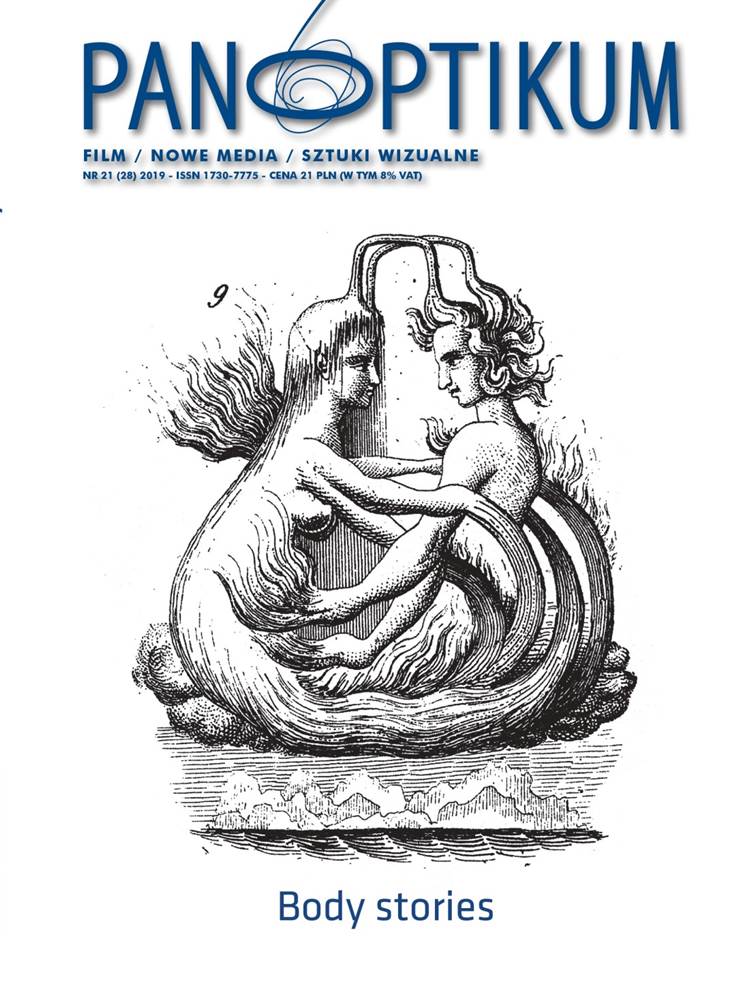Biometric trails of nonhuman environments. Medical imaging of plants’ bodies in bio-artistic projects
DOI:
https://doi.org/10.26881/pan.2019.21.03Słowa kluczowe:
body, affect, posthumanism, medical imaging, biometrics, plants, non-human actorsAbstrakt
The aim of the article is to introduce the problem of plants’ representations in the contemporary artistic projects based on medical imaging. The author analyses the problem in the perspective of posthumanistic philosophy, especially in reference to the theories of animal studies (Wolfe, Bakoff, Waldau). She also introduces the concept of Michael Marder, who builds his argument around the question of whether people are the only ones who have political, social and ethical rights. The second part of the article concerns strategies and method of plants’ bodies parametrization used in the selected artistic project. The author presents a few of them to show how artists investigate the problem of identity, autonomy and agency of non-human beings, with special regard to plants. The projects are analyzed in reference to various theories of connections between human and non-human beings, as well as to biopolitics’ strategies.
Downloads
Bibliografia
Alexenberg L (2011), The Future of Art in a Postdigital Age. From Hellenistic to Hebraic Consciousness, Bristol: Intellect Books.
Bakke M. (2010), Biotransfiguracje. Sztuka i estetyka posthumanizmu. Poznań: Wydawnictwo Naukowe UAM.
Beamer B. (1939), The Significance of the X-Ray in Veterinary Medicine, “Iowa State Uni- versity Veterinarian”, No. 3.
Bennett J. (2010), Vibrant Matter: A Political Ecology of Things, Durham-London: Duke University Press Books.
Bekoff M. (2006), Animal Passions and Beastly Virtues. Reflections on Redecorating Nature. Philadelphia: Temple University Press.
Braidotti R. (2013), The Posthuman, Cambridge: Polity Press.
Chamovitz D. (2012). What a Plan Knows: A Field Guide to the Senses, Scientific American. Farrar. Oxford: Straus and Giroux.
Clark N. (2016), X-ray exhibition marks artist’s return to health after serious illness. ”Independent”, 18.02. http://www.independent.co.uk/arts-entertainment/art/news/boo- beaumont-x-ray-exhibition-marks-artists-return-to-health-after-serious-illness-a6882556. html, (accessed: 27.07.2019).
Deleuze G., Guattari F. (2000), Co to jest filozofia?, (trans. P. Pieniążek), Gdańsk: Słowo/Obraz Terytoria.
Esbjorn-Hargens S., Zimmerman M. E., Bekoff M. (2009), Integral Ecology: Uniting Multiple Perspectives on the Natural World, Boston-London: Integral Books.
Fludernik M. (1996), Toward a Natural Narratology, London: Routledge 1996.
Grusin R. (2015), The Nonhuman Turn, Minneapolis-London: University of Minnesota Press.
Hall M. (2011), Plants as Persons: A Philosophical Botany, New York: State University of New York Press.
Karban R. (2015), Plant Sensing and Communication, Chicago: The University of Chicago Press.
Lamont T. Xrapics, https://xraypics.wordpress.com/history-of-x-ray-art-and-artists/, (ac- cessed: 27.07.2019).
Marder M. (2013), Should plants have rights?. “The Philosophers’ Magazine 3RD QUAR- TER”, No. 62.
S. E. McFarland, R. Hediger. (2009), Animal Agency. An Interdisciplinary Exploration, Leyden-Boston: BRILL.
Parikka J. (2010), Insect Media. An Archeology of Animals and Technology, Minneapolis- London: University of Minnesota Press.
Reikes M. C. (2003), Floral Radiography: Using X rays to Create Fine Art, “RadioGraphics”, Vol. 23, No. 5.
Schnelle G. B. (1968), The History of Veterinary Radiology. “Veterinary Radiology & Ultrasound”, No. 1.
Sierzputowski K. (2016), X-Ray Photographs From the 1930s Expose the Delicate Details of Roses and Lilies, “Colossal”, 02.02. https://www.thisiscolossal.com/2016/02/x-ray-flowers/ (accessed: 29.07.2019).
Squier S. M. (2004), Liminal Lives. Imaging the Human at the Frontiers of Biomedicine, Durham-London: Duke University Press.
Thrift N. (2008), Non-Representational Theory. Space, Politics, Affect, London-New York: Routledge.
Trewavas A. (2013), Plant Behaviour and Intelligence, Cambridge: Oxford University Press.
Waldau P. (2013), Animal Studies. An Introduction, Oxford-New York: Oxford University Press.
Wohlleben P. (2016), The Hidden Life of Trees. What They Feel, How They Communicate. Discoveries from a Secret World, Vancouver-Berkeley: Tim Flannery Greystone Books.
Wolfe C. (2010). What is Posthumanism?, London-Minneapolis: University of Minnesota Press.
Zylinska J. (2009), Bioethics in the Age of New Media, Cambridge, London: The MIT Press.

 Uniwersyteckie Czasopisma Naukowe
Uniwersyteckie Czasopisma Naukowe









